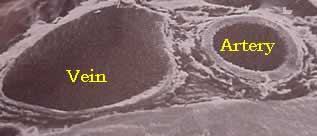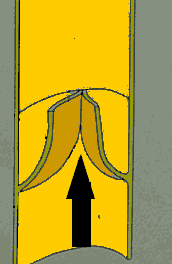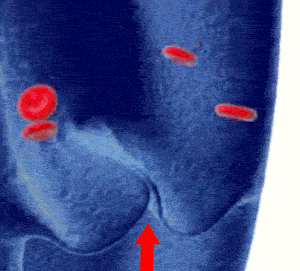Blood vessels

Blood travels through the body in tubes called blood vessels. Two types of blood vessels exist, veins and arteries.
Arteries carry blood away from the heart under high pressure. Veins carry blood to the heart under very low pressure.
Arteries have very thick, elastic walls that can cope with the blood travelling at high pressure. Veins on the other hand have thin walls as the blood travelling in them is at low pressure. Since the blood in the veins is at low pressure it has a tendency to settle in the legs. Travelling up the veins back to the heart is hard work. To assist blood to flow back to the heart, veins have tiny valves that allow blood to flow in the direction of the heart only.



The veins are visible on the surface of the arm. When significant blood flows through them the valves appear as small nodules.

To see how blood flows in one direction through veins do the following. Clamp a vein with your finger. With another finger squeeze the blood out of the vein by squeezing towards the heart. Still holding the vein clamped notice that blood does not flow backwards to fill the vein. When the clamp is released blood quickly fills the vein as it rushes towards the heart.

1) Answer true or false
a) Arteries are blood vessels that contain valves to assist in the flow of blood in one direction.
b) Veins carry deoxygenated blood
to the heart
c) Arteries carry blood of high pressure when compared to the blood in veins.
d) Both arteries and veins carry blood away from the heart.
e) Between heart beats blood flows away from the heart only..
f) Veins have thin walls compared to arteries.